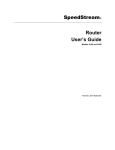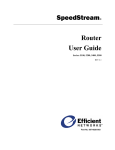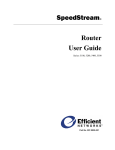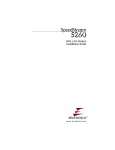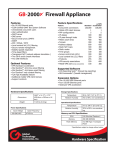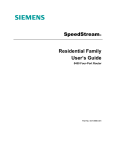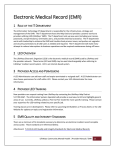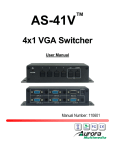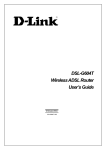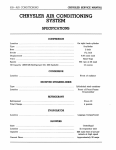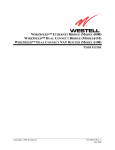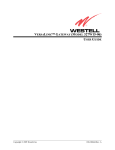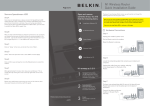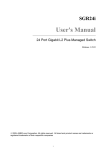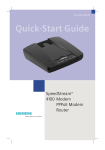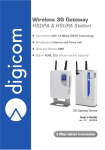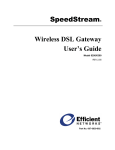Download SpeedStream Router User's Guide
Transcript
SpeedStream Router User’s Guide Model 4200 Part No. 007-4049-001 OPTUSnet 4200 Router User’s Guide Table of Contents Chapter 1 Introduction Features of the SpeedStream® Router ............................................................................................................. 1 Network (LAN) Features .............................................................................................................................. 1 Security Features ......................................................................................................................................... 2 Configuration & Management ...................................................................................................................... 2 Advanced Router Functions......................................................................................................................... 2 Minimum System Requirements......................................................................................................................... 3 General Safety Guidelines.................................................................................................................................. 3 Chapter 2 Installation Hardware Installation.......................................................................................................................................... 4 Ethernet Installation Method ........................................................................................................................ 4 USB Installation Method............................................................................................................................... 5 PC Configuration ................................................................................................................................................ 6 Checking TCP/IP Settings (Windows 9x/ME) .............................................................................................. 7 Checking TCP/IP Settings (Windows 2000)................................................................................................. 8 Checking TCP/IP Settings (Windows XP).................................................................................................... 9 Internet Access Configuration .......................................................................................................................... 10 For Windows 9x/2000 ................................................................................................................................ 10 For Windows XP ........................................................................................................................................ 10 Connecting to the Router.................................................................................................................................. 11 Chapter 3 Configuring User Profiles Add User Profiles.............................................................................................................................................. 13 Editing User Profiles ......................................................................................................................................... 17 Deleting User Profiles....................................................................................................................................... 18 Chapter 4 Configuring ISP Connection Settings WAN Interface .................................................................................................................................................. 19 Host .................................................................................................................................................................. 20 DHCP ............................................................................................................................................................... 21 Static Routes .................................................................................................................................................... 23 Chapter 5 Configuring Network Settings Mode................................................................................................................................................................. 25 UPnP (Universal Plug and Play)....................................................................................................................... 26 RIP (Routing Information Protocol)................................................................................................................... 27 Server Ports...................................................................................................................................................... 28 Dynamic DNS ................................................................................................................................................... 29 Chapter 6 Configuring Security Features Admin User....................................................................................................................................................... 31 Time Client ....................................................................................................................................................... 33 Firewall ............................................................................................................................................................. 34 Level........................................................................................................................................................... 35 Snooze ....................................................................................................................................................... 36 SIEMENS i OPTUSnet 4200 Router User’s Guide DMZ ........................................................................................................................................................... 37 Filter Rules ................................................................................................................................................. 38 Log ............................................................................................................................................................. 45 ADS............................................................................................................................................................ 46 Firewall Security Levels ............................................................................................................................. 48 Chapter 7 Monitoring Router Health Status and Statistics ......................................................................................................................................... 51 System Summary....................................................................................................................................... 52 System Log ................................................................................................................................................ 52 ATM Statistics ............................................................................................................................................ 53 DSL Statistics............................................................................................................................................. 53 Ethernet Statistics ...................................................................................................................................... 54 USB Statistics ............................................................................................................................................ 54 Routes........................................................................................................................................................ 55 Diagnostics ....................................................................................................................................................... 56 Tools................................................................................................................................................................. 57 Interface Map ............................................................................................................................................. 57 Reboot........................................................................................................................................................ 58 Chapter 8 Troubleshooting Interpreting the LED Display............................................................................................................................. 60 Resolving Specific Issues................................................................................................................................. 61 Contacting Technical Support .......................................................................................................................... 62 SIEMENS ii Chapter 1 Introduction Congratulations on the purchase of the SpeedStream Router with SecureRoute. The SpeedStream Router is a powerful yet simple communication device for connecting your computer or local area network (LAN) to the Internet. This manual covers SpeedStream model 4200. SpeedStream 4200 (Ethernet and USB) The SpeedStream 4200 can communicate through either an Ethernet or a USB connection. Features of the SpeedStream® Router The SpeedStream Router provides high-speed Internet and corporate network access to homes, networked home offices, and small offices. In addition, if you are working from a branch office, the Router provides a fast and effective means of communicating over a remote LAN with the main office. The Router can also be used to connect the corporate LAN to the Internet over the WAN. Network (LAN) Features • Ethernet Switch Ethernet connectivity to the Internet or network through a network interface card (NIC), providing full 10/100 megabits per second (Mbps) bandwidth to the port. • USB Connection Universal Serial Bus (USB) connection providing added flexibility for connecting your computer via the Ethernet or USB port. • Support of G.lite and Full-Rate DSL Ensures compatibility with most DSL networks. SIEMENS 1 OPTUSnet 4200 Router User’s Guide Chapter 1 Introduction Features of the SpeedStream® Router Security Features • Password-protected Configuration Password protection prevents unauthorized users from modifying the Router’s configuration settings. • Firewall Security Firewall security with four conveniently pre-set standard levels of security (Off, Low, Medium, High), an ICSA-compliant mode, and a custom setting for advanced users. • NAT Protection Network Address Port Translation (NAPT) and a secure firewall to protect your data while your computer is connected to the Internet. • Attack Protection System Attacks can flood your Internet connection with invalid data packets and connection requests, using so much bandwidth and so many resources that Internet access becomes unavailable. The Router incorporates protection against these types of attacks as well as other common hacker attacks. • Stateful Inspection Firewall All incoming data packets are monitored and all incoming server requests are filtered, thus protecting your network from malicious attacks from external sources. • Virtual Private Network Virtual Private Network allows remote users to establish a secure connection to a corporate network by setting pass-through of the three most commonly used VPN protocols: PPTP, L2TP, and IPSec. Configuration & Management • Easy Setup Use your Web browser for quick and easy configuration. • UPnP Support Universal Plug and Play (UPnP) allows automatic discovery and configuration of the SpeedStream Router. UPnP is supported by Windows Me, XP, or later, operating systems. Advanced Router Functions • DMZ One computer on your local network can be configured to allow unrestricted two-way communication with servers or individual users on the Internet. This provides the ability to run programs that are incompatible with firewalls. • Port Forwarding Port Forwarding provides flexibility by allowing you to change internal IP addresses without affecting outside access to your network. • Session Tracking Some protocols, such as FTP, require secondary network connections on ports other than the main control port. These connections are usually made using port numbers in the dynamic range (> 1024). The firewall allows traffic on secondary sessions without manual configuration. SIEMENS 2 OPTUSnet 4200 Router User’s Guide Chapter 1 Introduction Minimum System Requirements Minimum System Requirements At a minimum, your computer must be equipped with the following to successfully install the Router. Your Internet Service Provider (ISP) may have additional requirements for use of their service. • DSL service and an Internet access account from an Internet Service Provider (ISP). • Network cables for the device you intend to connect to the Router. Use standard CAT5 Ethernet cables with RJ45 connectors. • TCP/IP network protocol must be installed on all computers. • Ethernet connection method: – A network interface card (NIC) that supports Ethernet 10/100Base-T full-/half-duplex. – Operating system that supports TCP/IP. – Microsoft Internet Explorer or Netscape Navigator versions 5.0 or later. • USB connection method (if your router supports this method): – 32 MB RAM – Pentium-compatible 166 MHz processor (or faster). – 12 MB available hard disk space. – One of the following operating systems: – Windows 98, 98SE – Windows 2000 – Windows ME or XP – Mac OS versions 8.6 through 10.2.4 General Safety Guidelines When using the SpeedStream Router, observe the following safety guidelines: • • • • Never install telephone wiring during a storm. Avoid using a telephone during an electrical storm. Lightning increases the risk of electrical shock. Do not install telephone jacks in wet locations and never use the product near water. Do not exceed the maximum power load ratings for the product. SIEMENS 3 Chapter 2 Installation This chapter describes the steps you must take to install and configure the various components in your network to utilize the Siemens Broadband Internet Router. This includes setting up the hardware connections to the Internet router, configuring the PC to use the Internet router for Internet access, and setting up the router configuration. Hardware Installation You may position the Siemens broadband router at any convenient location where it will be well ventilated. Do not stack it with other devices or place it on the carpet. You can connect the router to an existing Ethernet port or USB port on your computer. Determine which connection method you want to use and follow the instructions below for the selected installation method: Ethernet or USB. Ethernet Installation Method To connect the SpeedStream device via the Ethernet interface, your computer must have an Ethernet adapter (also called a network interface card, or NIC) installed. If your computer does not have this adapter, install it before proceeding further. Refer to your Ethernet adapter documentation for complete installation instructions. Once you verify installation of an Ethernet adapter, perform the following procedure to connect the router to your computer. 1. With the PC powered off, connect the Ethernet cable to the Ethernet port on the router. 2. Connect the other end of the Ethernet cable to the Ethernet port on the PC. 3. Connect the DSL cable (resembles a telephone cord) to the DSL port on the rear of the router. To reduce the risk of fire, use the supplied telephone cable or an ACA approved cable to connect your DSL port on your router to a DSL telephone jack. 4. Plug the other end of the DSL cable into the wall socket. Ethernet port DSL connection Power switch Power supply 5. Connect the power adapter to the rear of the router. 6. Plug the power adapter into the electrical wall outlet. 7. Flip the power switch on the router. 8. Power on all connected computers. You can now configure the TCP/IP settings as detailed in the PC Configuration section. SIEMENS 4 Chapter 2 Installation Hardware Installation OPTUSnet 4200 Router User’s Guide USB Installation Method 1. With your PC powered off, connect the USB cable to the USB port on the router. 2. Connect the other end of the USB cable to an open USB port on your PC. 3. Connect the DSL cable (resembles a telephone cord) to the DSL port on the router. To reduce the risk of fire, use the supplied telephone cable or an ACA approved cable to connect your DSL port on your router to a DSL telephone jack. 4. Plug the other end of the DSL cable into the wall socket. USB port DSL connection Power switch Power supply 5. Connect the power adapter to the rear of the router. 6. Plug the power adapter into the electrical wall outlet. 7. Power on all connected PCs. 8. Insert the USB driver CD-ROM into the CD-ROM drive of your PC. 9. When prompted, follow the on-screen instructions to complete the driver installation. 10. Flip the power switch to power on the router. You can now configure the TCP/IP settings as detailed in the PC Configuration section. SIEMENS 5 OPTUSnet 4200 Router User’s Guide Chapter 2 Installation PC Configuration PC Configuration This section explains how to configure your personal computer to work with the Router. To access the Internet through the SpeedStream Router, your PC must be configured to use the TCP/IP protocol suite over the Internet, and to accept Dynamic Host Configuration Protocol address assignments from the router. The default network settings for the SpeedStream Router are: IP Address:10.1.1.1 Subnet Mask:255.255.255.0 By default, the Router will act as a DHCP server, automatically providing a suitable IP address and related information to each computer when the computer boots up. For all non-server versions of Windows, the TCP/ IP setting defaults to act as a DHCP client. (If using the default Router settings and the default Windows TCP/ IP settings, you do not need to make any changes.) Although these are the default settings for the PC, it is a good idea to verify that they have not been changed. If TCP/IP is not already installed on your computer, refer to your system documentation or online help for instructions. Once installed, you should check the TCP/IP protocol settings to make sure they are correct for use with the Router. The instructions to check TCP/IP protocol settings differ between operating system. Check the settings using the instructions for your operating system: • Checking TCP/IP Settings (Windows 9x/ME) • Checking TCP/IP Settings (Windows 2000) • Checking TCP/IP Settings (Windows XP) SIEMENS 6 OPTUSnet 4200 Router User’s Guide Chapter 2 Installation PC Configuration Checking TCP/IP Settings (Windows 9x/ME) 1. Select Start>Control Panel >Network. This displays the Configuration tab on the Network page. 2. Select the TCP/IP protocol for your network card. 3. Click Properties. This displays the TCP/IP Properties page. 4. Click the IP Address tab. 5. Ensure that the Obtain an IP address automatically option is selected. This is the default Windows setting. 6. Close this page. 7. Restart your computer to ensure it obtains an IP address from the Router. 8. Configure internet access using the procedure described in Internet Access Configuration. SIEMENS 7 OPTUSnet 4200 Router User’s Guide Chapter 2 Installation PC Configuration Checking TCP/IP Settings (Windows 2000) 1. On the Windows taskbar click Start>Settings>Control Panel. This displays the Control Panel page. 2. Double-click Network and Dial-up Connections. This displays the Network and Dial-up Connections page. 3. Right-click Local Area Connection and select Properties. This displays the Local Area Connections Properties page. 4. Select the TCP/IP protocol for your network card. 5. Click Properties. This displays the Internet Protocol (TCP/IP) Properties page. 6. Select the Obtain an IP address automatically and Obtain DNS server address automatically options. Exit back to the Control Panel. 7. Restart your computer to ensure it obtains an IP address from the Router. 8. Configure internet access using the procedure described in Internet Access Configuration. SIEMENS 8 OPTUSnet 4200 Router User’s Guide Chapter 2 Installation PC Configuration Checking TCP/IP Settings (Windows XP) 1. On the Windows taskbar click Start>Control Panel. This displays the Control Panel page. 2. Double-click the Network Connection icon. This displays the Network Connections page. 3. Right-click Local Area Connection, then click Properties. This displays the Local Area Connection Properties page. 4. Select the TCP/IP protocol for your network card. 5. Click Properties. This displays the Internet Protocol (TCP/IP) Properties page. 6. Ensure that Obtain an IP address automatically and Obtain DNS server address automatically are selected. 7. Exit back to the Control Panel. 8. Restart the computer to ensure it obtains an IP address from the Router. 9. Configure internet access using the procedure described in Internet Access Configuration. SIEMENS 9 OPTUSnet 4200 Router User’s Guide Chapter 2 Installation Internet Access Configuration Internet Access Configuration Windows users must configure their computers to use the Router for Internet access. Ensure that the Router is installed correctly and the DSL line is functional. Then follow the appropriate procedure below to configure your Web browser to access the Internet via the LAN, rather than by a dial-up connection. For Windows 9x/2000 1. Select Start>Settings>Control Panel to display the Control Panel. 2. Double-click the Internet Options icon. This displays the Internet Properties page. 3. Click the Connections tab. 4. Click Setup. 5. Click I want to set up my Internet connection manually, or I want to connect through a local area network (LAN), then click Next. This displays the Internet Connection Wizard page. 6. Click I connect through a local area network (LAN), then click Next. This displays the Local Area Network Internet Configuration page. 7. Ensure all the boxes are deselected, then click Next. This displays the Set Up your Internet Mail Account page. 8. Click No, then click Next. This displays the Completing the Internet Connection Wizard page. 9. Click Finish to close the Internet Connection Wizard. Setup is now complete. 10. Configure the Router using the procedure described in Connecting to the Router. For Windows XP 1. Select Start>Control Panel. 2. Double-click the Internet Options icon. This displays the Internet Options page. 3. Click the Connections tab. 4. Click Setup. This starts the New Connection Wizard. 5. Click Next. 6. Select Connect to the Internet, then click Next. 7. Select Setup my connection manually, then click Next. 8. Select Connect using a broadband connection that is always on, then click Next. 9. Click Finish. 10. Configure the Router using the procedure described in Connecting to the Router. SIEMENS 10 OPTUSnet 4200 Router User’s Guide Chapter 2 Installation Connecting to the Router Connecting to the Router The SpeedStream Router contains an HTTP server that allows you to connect to the Router and configure it from your Web browser (Microsoft Internet Explorer or Netscape Navigator, versions 5.0 or later). To establish a connection from your computer to the Router: 1. After installing the Router, start your computer. If your computer is already running, reboot it. 2. Open your Internet Explorer or Netscape Navigator Web browser. 3. In the Address bar, enter the default router IP address: http://speedstream and press Enter. This displays the Home page. 4. Click Login on the left navigation pane to log into the router. This displays the Login page. 5. By default the username is admin. There is no password set for the admin login. Click OK. This displays the Home page once again. 6. Click OK. This displays the screen for the menu option you selected. SIEMENS 11 OPTUSnet 4200 Router User’s Guide Chapter 2 Installation Connecting to the Router 7. Refer to the following chapters for information on how to use each of these options. • Refer to the Chapter titled "Installation", for details on adding, modifying, or deleting user profiles. • Refer to Chapter titled "Configuring ISP Connection Settings", for details on setting ISP configuration parameters. This should only be done when instructed by your ISP. • Refer to Chapter titled "Configuring Network Settings", for details on configuring network related information. • Refer to Chapter titled "Configuring Security Features", for details on adding security to your network. • Refer to Chapter titled "Monitoring Router Health", for details on viewing network statistics and connection status. SIEMENS 12 Chapter 3 Configuring User Profiles This chapter contains details for configuring users on the SpeedStream Router. User profiles are used as a means for controlling Router and network access by individual users. Access to the configuration and management of the Router should be restricted to authorized users only. This chapter describes how to: • Add User Profiles • Editing User Profiles • Deleting User Profiles Add User Profiles To add a new user profile: 1. Select Setup>User Profiles from the left navigation pane of the Web interface. This displays the Current Profiles page. User profiles are added using a Wizard accessed from this page. 2. Optionally select the Force all users to be identified before surfing option. 3. Click New Profile. This displays the Profile User Information page. SIEMENS 13 OPTUSnet 4200 Router User’s Guide Chapter 3 Configuring User Profiles Add User Profiles 4. Enter a Username for the user you are adding. 5. Optionally enter a Password for the user and Confirm it. 6. Click Next. This displays the Profile Content Filtering page. Content filtering restricts access to undesirable Web sites and Web content. 7. Select one of the following content filtering options: • Disable all Content Filtering User has access to all Internet content without restrictions. • Allow access only to website addresses containing the following words User has access only to the specified Web addresses or to addresses containing specified word entries defined in the Website word/name table. • Deny all access to website addresses containing the following words User is denied access to all Web addresses specified as well as addresses that contain any words specified in the Website word/name table. 8. If either the Allow access only… or Deny all access… option is selected, type a word or Web address in the box under the Website word/name table and click Add Entry. The system responds by adding the word or Web address to the Website word/name table. This can be done multiple times to add different entries to the table. Note: The entries in the Website word/name table may be either modified or deleted at any time by clicking either Edit or Delete next to the corresponding word or Web address. SIEMENS 14 OPTUSnet 4200 Router User’s Guide 9. Chapter 3 Configuring User Profiles Add User Profiles Click Next. This displays the Profile Configuration Access page. Profile configuration access defines the access permission for a user controlling what functions and features are available to that user. 10. Optionally do one of the following: • Click one or more of the available features permitting the user to access that feature. This places a checkmark in the corresponding box. (Click again if you want to remove the checkmark and deny access). • Click All Items to select all features in the list. • Click Reset to clear all selected items and deny the user access to those feature. 11. Click Next. This displays the Profile Security Access page. 12. Click one of the following: • Require admin login to access configuration pages User must login as admin to change the Router configuration. This is the recommended setting. • Do not require admin login User will be able to change the Router configuration without a password. SIEMENS 15 OPTUSnet 4200 Router User’s Guide Chapter 3 Configuring User Profiles Add User Profiles 13. Click Next. This displays the Constant Profile IP Address page. 14. Optionally enter an IP Address to always be associated with this profile. 15. Click Next. 16. This completes the User Profile Wizard. Click Finish to close the Wizard and return to the Current Profiles page. SIEMENS 16 OPTUSnet 4200 Router User’s Guide Chapter 3 Configuring User Profiles Editing User Profiles Editing User Profiles This section describes how to edit a user. To edit a user: 1. Select Setup>User Profiles from the left navigation pane of the Web interface. This displays the Current Profiles page listing all currently configured users. 2. Click the name of the user you want to change. This displays the Profile User Information page. Make any desired changes. 3. Click Next to get to the next page you want to change. Make any desired changes. 4. Click Finish at any time when you are done making changes. SIEMENS 17 OPTUSnet 4200 Router User’s Guide Chapter 3 Configuring User Profiles Deleting User Profiles Deleting User Profiles This section describes how to delete a user. To delete a user: 1. Select Setup>User Profiles from the left navigation pane of the Web interface. This displays the Current Profiles page. 2. Click the Delete button next to the name of the user you want to delete. SIEMENS 18 Chapter 4 Configuring ISP Connection Settings This chapter describes how to set advanced ISP connection settings. The options in this section should only be configured with the help and guidance of your ISP. Incorrect changes to any of these options could result in the failure of your internet connection. The ISP connection options are listed below. WAN Interface Wizard for configuring the WAN Interface. The information requested by the Wizard should be supplied by the service provider. Host Configure the basic networking attributes of the Router (the host). DHCP Configure and control Dynamic Host Configuration Protocol (DHCP) and DNS functionality. Static Routes Add and monitor static IP routes assigned by your ISP. The routing functionality of the Router supports both Dynamic Routing and Static Routing. Static routing pertains to those routes between network-connected hosts that do not change over time. WAN Interface Connectivity to the Wide Area Network (WAN) is achieved by means of one or more Virtual Circuits (VC). Virtual Circuits are configured using the WAN Interface Configuration Wizard. The information requested by the Wizard should be supplied by the service provider. SIEMENS 19 OPTUSnet 4200 Router User’s Guide Chapter 4 Configuring ISP Connection Settings Host Host Host configuration attributes identify the Router on the network and, optionally, specify a default “gateway” to the Wide Area Network (WAN). Default values for many host IP address, netmask, default router and host name are automatically generated for the SpeedStream Router and should not be changed unless directed by your ISP. The ISP may ask you to change this information if, for example, you are assigned a static IP address. To specify host configuration settings: 1. Select Setup>Host from the left navigation pane of the Web interface. This displays the Host Configuration page. 2. Change settings as specified by your ISP. 3. Click Save Settings. This displays a confirmation screen displays notification that the new setting will not take affect until you reboot the router. You may do so at this point or later. SIEMENS 20 OPTUSnet 4200 Router User’s Guide Chapter 4 Configuring ISP Connection Settings DHCP DHCP DHCP, the Dynamic Host Configuration Protocol, describes the means by which a system can connect to a network and obtain the necessary information for communication upon that network. Do not change the default DHCP Configuration settings unless directed by your ISP. Note: All addresses must be entered as an Ipv4 subnet mask in dotted-decimal notation (for example, 255.255.255.0). To configure the DHCP feature: 1. Select Setup>DHCP from the left navigation pane of the Web interface. This displays the DHCP Configuration page. 2. Select one of the following: • Enable The Router will operate as a DHCP server to handle DHCP requests received from connected LAN-side hosts (DHCP clients). The DHCP server does not serve WAN-side DHCP clients. The DHCP operating mode defaults to Enable, and the system auto-generates the current IP address range, IP netmask, and default router. Do not change these default settings unless directed by your ISP. • Disable Disables DHCP. If you are using a static IP address, you may need to disable DHCP and enter different addresses in the text boxes. • DHCP Relay Instead of getting an IP address from the Router, the IP address is gotten from the computer as defined in Relay IP. Used when DHCP information is received from a DHCP server on the WAN side. DHCP requests are forwarded to the WAN side to Relay IP, and DHCP responses are forwarded back to the LAN side. 3. In Client IP Address, enter the beginning IP address of the range of addresses from which the DHCP server will lease to requesting DHCP clients. SIEMENS 21 OPTUSnet 4200 Router User’s Guide Chapter 4 Configuring ISP Connection Settings DHCP 4. In IP Netmask, enter the IP subnet mask that corresponds to the range of IP addresses defined above. 5. In Default Gateway, do one of the following: • Enter the IP address of a default gateway, or router, to be provided to DHCP clients. • Click Self to specify that the SpeedStream Router is to be used as the default gateway. 6. In DNS Server (primary), do one of the following: • Enter IP address of the primary Domain Name System (DNS) server to be provided to DHCP clients. A DNS server may be used by clients to resolve domain names to IP addresses. • Click Use WAN to specify that the address of the DNS server provided by your ISP is provided to DHCP clients on the LAN. 7. In Domain Name, optionally enter the DNS domain name for the DHCP server resident on your SpeedStream device. This value must be entered as an alpha-numeric string. 8. In Lease Time, do one of the following: • Enter the period of time an IP addresses leased from the DHCP server is valid. At the end of the lease period, the DHCP client will transmit a request to the server to extend the lease, at which time the server will extend the lease period of the IP address assigned to the client. If the lease period expires without the server receiving a request from the client to extend the lease, the server will assume the client’s connection no longer exists. The server will release the IP address assigned to the client and return the address back to the pool of available addresses. (If you select this option, you must specify a DNS Server.) • Click Infinite Time: Leaves the lease time open-ended, preventing the server from releasing the IP address. 9. Click Save Settings. SIEMENS 22 OPTUSnet 4200 Router User’s Guide Chapter 4 Configuring ISP Connection Settings Static Routes Static Routes The SpeedStream DSL Router directs data traffic by “learning” source and destination information, then building a routing table. In some cases, network mappings cannot be learned because of incompatible addressing schemes. Sometimes a different source and destination path may be desired over the learned paths for example when your ISP assigns you a static route. In these situations, Static Routes can be configured to map a desired pathway. Use the static routes advanced option to configure static routes to remote equipment. Static routing allows a pre-defined route to be set for the transmission of data. Static routes take precedence over all dynamic routing options and also provide enhanced security over dynamic routing. To configure a static route: 1. Select Setup>Static Routes from the left navigation pane of the Web interface. This displays the Static Route Configuration page. 2. Under Add Route, type the IP address of the destination device in the Destination box. 3. Type the net mask of the destination device in the Net Mask box. 4. Optionally, type the IP address where the data packets will be forwarded in the Next Hop box. 5. Select a connection type from the Interface drop-down menu. This is the interface that will forward the packets. 6. Click Apply. The system responds by adding your new route to the routing table. 7. You can repeat this procedure for each static route you wish to add. Note: To edit a static route, click the Edit column for the static route you want to edit. Note: To delete a static route, click the Delete column for the static route you want to delete. SIEMENS 23 Chapter 5 Configuring Network Settings This section contains details for configuring network-related information. The network settings options are listed below. Mode Configure the operation mode for the router. UPnP (Universal Plug Configure and control UPnP inter operability and security. and Play) Activate and control RIP functionality. Using RIP, the Router is able to determine the RIP (Routing Information Protocol) shortest distance between two points on the network based on the addresses of the originating devices. Server Ports Specify server ports used by common applications such as HTTP (Web site traffic), FTP, and Telnet. Dynamic DNS Set up Dynamic DNS. Dynamic DNS translates IP addresses into alphanumeric names. For example, an IP address of 333.136.249.80 could be translated into siemens.com. SIEMENS 24 OPTUSnet 4200 Router User’s Guide Chapter 5 Configuring Network Settings Mode Mode To select the operation mode for the router: 1. Select Mode from the left navigation pane of the Web interface. This displays the Mode selection page. 2. Select one of the following operation modes. Upon selection, all associated parameters are set automatically for the router to operate according to the selected mode. • Optus Bridge Select this option if you are connected to one device. • NAPT Hosts located on a Local Area Network (LAN) are often required to use private IP addresses as opposed to public IP addresses. Private IP addresses, however, are not known on the public Wide Area Network (WAN). In order to expose LAN-side hosts assigned private IP addresses to the public WAN, the Router can be configured to use Network Address Port Translation (NAPT). NAPT can expose multiple LANside hosts. • Full Bridge The router acts as a bridge. Point-to-Point (PPP) connections are not available under the bridge mode of operation. Important!ISwitching to Full Bridge will lose access to the Web interface. 3. Click Apply. SIEMENS 25 OPTUSnet 4200 Router User’s Guide Chapter 5 Configuring Network Settings UPnP (Universal Plug and Play) UPnP (Universal Plug and Play) Microsoft UPnP allows the Router to communicate directly with certain Windows operating systems to trade information about the special needs of certain applications (such as messaging programs and interactive games) as well as provide information about other devices on the network, where applicable. This communication between the operating system and Router greatly reduces the amount of manual configuration required to use new applications and devices. Only certain versions of Windows XP and computer support the UPnP (Universal Plug and Play) function. Before configuring this option, you must ensure that the UPnP component is installed on your computer and enabled. To enable UPnP functionality: 1. Select Setup>UPnP from the left navigation pane of the Web interface. This displays the UPnP Configuration page. 2. Select one of the following control options. • Disable UPnP Prevents the Router from using the UPnP feature to communicate with other devices or your operating system. Also may be disabled if your operating system does not support UPnP. • Enable Discovery and Advertisement only (SSDP) Sends information about new devices (hardware) detected only. No information concerning software applications or services is transmitted. • Enable full Internet Gateway Device (IGD) support Allows the Router to communicate freely with computers on the network about new devices, software applications, and services as needed to ensure they are working with minimal manual configuration required. 3. Select one of the following options: • Enable access logging Generates a system log message whenever an UPnP client accesses the router. • Read-only mode Restricts the kind of access an UPnP client can have into the router. Only requests in the UPnP protocol that query the status of the router are allowed. Any requests that could potentially modify the router’s behavior are blocked. 4. Click Apply to accept the settings. This displays the UPnP Finish page. SIEMENS 26 OPTUSnet 4200 Router User’s Guide Chapter 5 Configuring Network Settings RIP (Routing Information Protocol) RIP (Routing Information Protocol) By default, the SpeedStream Router does not support routing protocols. However, support for the Routing Information Protocol (RIP), versions 1, 2 or 1 and 2, can be activated. This support may be configured for any WAN connection currently configured or for the LAN in general. Using RIP, the Router is able to determine the shortest distance between two points on the network based on the addresses of the originating devices. RIP is based on distance algorithms to calculate the shortest path using information in the routing table. The shortest path is based on the number of hops between two points. To activate the RIP option: 1. Select Setup>RIP from the left navigation pane of the Web interface. This displays the RIP Configuration page. 2. Select one of the following options from under the RIP Version heading next to the connection of your choice: • 1: Provides essential RIP packet formatting for routing information packets. • 2: Provides enhanced packet formatting for routing information packets by providing the following: IP address, subnet mask, next hop, and metric (shows how many routers the routing packet crossed to its destination. • 1&2: A combination of both types of RIP packets. 3. Select an Active Mode checkbox next to a corresponding connection to enable it. 4. Select a Multicast checkbox next to a corresponding connection to enable it. 5. Click Apply. This displays the Your Settings Have Been Saved page. 6. Optionally, click Reboot if you wish for the settings to immediately be implemented. The system responds by restarting your Router. SIEMENS 27 OPTUSnet 4200 Router User’s Guide Chapter 5 Configuring Network Settings Server Ports Server Ports Common applications such as HTTP (Web site traffic), FTP, and Telnet use pre-defined incoming port numbers for compatibility with other services. If you wish to change the ports used by these applications you may do so using this option. This feature is recommended for use by advanced users only. To configure the server port option: 1. Select Setup>Server Ports from the left navigation pane of the Web interface. This displays the SpeedStream Gateway Server Ports page. 2. Optionally, type a port number in the HTTP box. The default port for this field is 80. 3. Optionally, type a port number in the FTP box. The default port for this field is 21. 4. Optionally, type a port number in the Telnet box. The default port for this field is 23. 5. Click Apply. This displays the Your settings have been saved page. 6. Optionally, click Reboot if you wish for the settings to immediately be implemented. The system responds by restarting your Router. SIEMENS 28 OPTUSnet 4200 Router User’s Guide Chapter 5 Configuring Network Settings Dynamic DNS Dynamic DNS Use the dynamic DNS advanced option to set up Dynamic DNS. Dynamic DNS translates IP addresses into alphanumeric names. For example, an IP address of 211.29.132.105 could be translated into www.optusnet.com.au. To use the DDNS service, you must register for the service. You can register from the following web page: www.dydns.org/services/dydns. Once registered, you must set up your DNS data on the Router. Once this is done, users can connect to your servers (or DMZ computer) from the Internet using your Domain name. Refer to the section in this document titled DMZ for more information on DMZs. To set up Dynamic DNS on the Router: 1. Select Setup>Dynamic DNS from the left navigation pane of the Web interface. This displays the Set Up Dynamic DNS page. 2. Select the Enable option under Dynamic DNS Client. 3. Type the name provided to you by www.dydns.org in the Service Username box. 4. Type your www.dydns.org password in the Password box. 5. Type the domain or host name provided by www.dydns.org in the Host Name 1 box. 6. Optionally, if you have more than one domain or host name, type it in the Host Name 2 box. 7. Click Apply. The system responds by registering your domain or host name to www.dydns.org. SIEMENS 29 Chapter 6 Configuring Security Features The Router provides broad security measures against unwanted users. Security also allows for the configuration of the firewall, administrator password, NAT (Network Address Translation), and DMZ (Demilitarized Zone) configuration. The security options are listed below. Admin User Manage administrator login name and password. Time Client Configure network-based date and time functionality. An accurate date and time is of use when logging system and firewall events and is a requirement for some firewall functionality (e.g., ICSA-compliant firewall operation). Firewall Configure and control the internal firewall. Many of these features require a thorough understanding of networking principles and firewall operations. The firewall options are listed below. SIEMENS 30 OPTUSnet 4200 Router User’s Guide Chapter 6 Configuring Security Features Admin User Admin User The Administrator profile controls the requirements for logging into the Web interface and accessing configuration pages, as well as defining the administrator login name and password. To configure administrator settings: 1. Select Setup>Admin User from the left navigation pane of the Web interface. This displays the Login page. 2. Do one of the following: • If this is the initial setup, enter admin in User name and click OK. (By default, the admin account does not have a Password defined.) • If you have already defined a password for the admin account, enter admin in User Name and the assigned password in Password. Then click OK. This displays the Gateway Administrator Setup page. 3. Specify a user name for the administrator. You may accept the default user name, admin, or enter a new user name in User Name. The user name is case-sensitive. 4. Enter a password in New Password; then enter the same password in Confirm New Password. The password field is case-sensitive. 5. Select a login security level from one of the following: • Require admin login to access entire Web site Before you can access any screen in the Web interface, you must log in with your network user name and password. (Security level = High) SIEMENS 31 OPTUSnet 4200 Router User’s Guide Chapter 6 Configuring Security Features Admin User • Require admin login to access configuration pages Before you can access any screen in the Web interface that allows you to make configuration changes, you must log in with your network user name and password. (Security level = Medium) • Do not require admin login After you log in for the first time, you will not be required to log in again at any screen. (Security level = Low) 6. Click Save Settings. SIEMENS 32 OPTUSnet 4200 Router User’s Guide Chapter 6 Configuring Security Features Time Client Time Client An accurate log timestamp is one of the requirements of the ICSA Labs firewall criteria (ver 3.0a). In order to maintain accurate timestamps in each log message, the firewall implements a Simple Network Time Protocol (SNTP) client. This allows the system to automatically synchronize its date and time with Coordinated Universal, the international time standard. The system date and time are set and corrected automatically via the designated server(s). To configure the time client: 1. Select Setup>Time Client from the left navigation pane of the Web interface. This displays the Time Client Configuration page. 2. Select Enable from Enable Time Client. 3. In Primary Server IP Address, enter the FQDN of the primary server to use as the time server (a “wellknown” Network Time Protocol Server). 4. In Secondary Server IP Address enter the IP address of the secondary server to use as the time server if the router does not receive a response from the primary server. 5. In Select Time Zone, enter the time zone in minutes from UTC. 6. Click Apply. SIEMENS 33 Chapter 6 Configuring Security Features Firewall OPTUSnet 4200 Router User’s Guide Firewall A firewall is a system designed to prevent unauthorized access to or from a private network. The firewall is designed to protect hosts located on the Local Area Network (LAN) from attacks initiated on the Wide Area Network (WAN). Protection is not provided for attacks initiated from the LAN. Due to the nature of firewall operations and the system resources required to service these operations, firewall operations may degrade the performance of the Router – especially under heavy network traffic loads. The firewall menu item accessible from the left navigation pane of the Web interface expands to provide a list of options to be enabled or disabled as well as links to configure the more complex details of each security feature. Level Set the firewall security level. Snooze Temporarily disable the firewall. It is important to note that when the firewall is snoozing all protection provided by the firewall is disabled. DMZ Configure firewall DMZ for controlling a virtual DMZ on the Local Area Network. The purpose of the DMZ is to redirect suspicious network traffic received from a public WAN to a secured LAN-side host dedicated to this purpose. Filter Rules Add and delete custom inbound and outbound firewall rules. Log View log listing of firewall activity including records of denial of access, reason codes, and descriptions. ADS Configure what events the internal Attack Detection System (ADS) will protect against and log from a list of well-known attacks initiated on the Wide Area Network. SIEMENS 34 OPTUSnet 4200 Router User’s Guide Chapter 6 Configuring Security Features Firewall Level The firewall contained within the Router may be configured to operate in one of several modes, referred to as levels. For ease of use, three generic levels are preconfigured – Low, Medium and High. A separate level, ICSA 3.0a Compliant, is provided for those users who require compliance with the criteria set forth by ICSA Labs for firewall behavior. (Please refer to Firewall Security Levels for a detailed description of these preconfigured levels.) In addition to the preconfigured levels, a Custom level is provided for advanced users who require the capability to define a unique custom set of firewall rules. To specify the firewall security level: 1. Select Setup>Firewall>Level from the left navigation pane of the Web interface. This displays the Firewall Level Configuration page. 2. Select one of the following from the Select Firewall Level drop-down menu. • Off No restrictions are applied to either inbound or outbound traffic. In addition, Network Address Port Translation (NAPT) functionality is disabled. Because there is no address/port translation when the firewall is placed in this mode, all LAN-side connected hosts must be assigned a valid public IP address. • Low Minimal restrictions with respect to outbound traffic. Outbound traffic is allowed for all supported IPbased applications and Application Level Gateways (ALGs). The only inbound traffic allowed is traffic received within the context of an outbound session initiated on the local host. • High High restrictions with respect to outbound traffic. Outbound traffic is allowed only for a very restricted set of supported IP-based applications and ALGs. The only inbound traffic allowed is traffic received within the context of an outbound session initiated on the local host and permitted by this firewall mode. • Custom Allows advanced users to add, modify, and delete their own firewall rules. If you select this option, you must set customized rules for both inbound and outbound traffic using the IP Filtering option. 3. Click Apply. SIEMENS 35 OPTUSnet 4200 Router User’s Guide Chapter 6 Configuring Security Features Firewall Snooze The snooze feature allows you to temporarily disable the firewall for a set amount of time so outside support personnel can access your Router or network or so you can run an application that conflicts with the firewall. Note: Important! This function is recommended for use only when you require this special level of unrestricted access as it leaves your Router and network exposed to the Internet with no firewall protection. To enable and configure snooze control: 1. Select Setup>Firewall>Snooze from the left navigation pane of the Web interface. This displays the Firewall Snooze Control page. 2. Select one of the following: • Disable Snooze Disables all snooze control. In this mode, the firewall is not disabled. • Enable Snooze, and set the Snooze time interval to Enables snooze for a specified time period. Be sure to enter the number of minutes to define how long the firewall should be disabled. • Reset the Snooze time interval to Reset the snooze control time period. Use this option if you need a time extension for an open snooze session. Be sure to specify the additional amount of time (minutes) the firewall should be disabled. 3. Click Apply. SIEMENS 36 OPTUSnet 4200 Router User’s Guide Chapter 6 Configuring Security Features Firewall DMZ The firewall supports virtual DMZ. Virtual DMZ redirects traffic to a specified IP address rather than a physical port. Because this redirection is a logical application rather than physical, it is called “virtual DMZ.”. Using virtual DMZ, a single node on the LAN can be made “visible” to the WAN IP network. Any incoming network traffic not handled by port forwarding rules is automatically forwarded to an enabled DMZ node. Outbound traffic from the virtual DMZ node circumvents all firewall rules. The DMZ feature allows a computer on your home network to circumvent the firewall and have direct access to the internet. This feature is primarily used for gaming. Under this mode of operation all network traffic received from the WAN that is not destined for a host specifically exposed through NAT or for a server exposed through Port Forwarding will be redirected to the designated DMZ host. If the DMZ feature is enabled, you must select the computer to be used as the DMZ computer/host. This function is recommended for use only when you require this special level of unrestricted access as it leaves your Router and network exposed to the Internet with no firewall protection. To enable and configure the DMZ: 1. Select Setup>Firewall>DMZ from the left navigation pane of the Web interface. This displays the Firewall DMZ Configuration page. 2. Select one of the following DMZ enable options: • Disable DMZ The firewall is not bypassed. • Enable DMZ with this Host IP address The firewall is bypassed through an IP address typed in the box next to this field. • Enable DMZ with this Host IP address The firewall is bypassed through an IP address that is selected from the Select Host drop-down menu next to this field. Select the desired host from the drop-down menu. 3. Select one of the following time element options: • Make Settings Permanent DMZ settings are permanent unless changed by the administrator. • Make Settings Last for DMZ settings last for only the time (in minutes) entered in the box next to this option. 4. Click Apply. SIEMENS 37 OPTUSnet 4200 Router User’s Guide Chapter 6 Configuring Security Features Firewall Filter Rules If the firewall security level is set to Custom, this features allows you to specify a unique set of firewall rules for handling inbound and outbound traffic customized to the user’s specific requirements. In this mode of operation the firewall provides an extensive amount of configurability. As such, only advanced users should employ this feature. Rules can be filter-based on any of the following: • • • • • • Source and destination router interfaces IP protocols Direction of traffic flow Source and destination network/host IP address Protocol-specific attributes such as ICMP message types Source and destination port ranges (for protocols that support them), and support for port comparison operators such as less than, greater than, and equal to. Rules can specifically allow or deny packets to flow through the router. Default actions taken when no specific rule applies can also be configured. To define inbound and outbound IP filter rules: 1. Select Setup>Firewall>Filter Rules from the left navigation pane of the Web interface. This displays the Firewall IP Filter Configuration Wizard page. 2. Do one of the following: • To add new IP filter rules as you define them, click Add New IP Filter Rule. This displays the Basic Rule Definition page. • To clone IP filter rules already defined, click Clone IP Filter Level. This displays the Clone Rule Definition page. Once cloned, you can modify the existing rules. SIEMENS 38 OPTUSnet 4200 Router User’s Guide Chapter 6 Configuring Security Features Firewall Create Custom IP Filter Rules To add a new rule: 1. Type up to a five digit numeric value in the Rule No box to uniquely identify the rule. 2. Select either Permit or Deny from the Access drop-down menu. Select Permit to allow the rule and Deny to prohibit the rule. 3. Select either Inbound or Outbound from the Direction drop-down menu. Inbound refers to data coming into the Router, while Outbound refers to data transmitted from the Router. 4. Optionally, select the Disable stateful inspection for packets matching this rule to prevent the firewall from creating a stateful inspection session for packets matched on this rule. 5. Optionally, select the Create a log entry for packets matching this rule. When selected, an entry is placed in the log file when packets match this rule. 6. Click Next. This displays the Source & Destination Definition page. 7. Under the Source heading, select a network connection from the Network Interface drop-down menu. SIEMENS 39 OPTUSnet 4200 Router User’s Guide Chapter 6 Configuring Security Features Firewall 8. Select one of the following options: • Any IP Address Select this option if this rule applies to any IP address from the source. • This IP Address Select this option if a rule applies to a specific IP address from the source. 9. If you selected This IP Address, enter an IP address in the IP Address field. And do one of the following: • Enter a netmask in the Netmask field. • Or, select or Host to use your Router netmask as the source netmask. 10. Under the Destination heading, select a network connection from the Network Interface drop-down menu. 11. Select one of the following options: • Any IP Address Select this option if this rule applies to any IP address of the destination. • This IP Address Select this option if a rule applies to a specific IP address of the destination. 12. If you selected This IP Address, enter an IP address in the IP Address field. And do one of the following: • Enter a netmask in the Netmask field. • Or, select or Host to use your Router netmask as the destination netmask. 13. Click Next. This displays the Protocol Definition page. 14. Do one of the following: • Select one of the following protocol options from the Select by Name drop-down menu. This defines the types of packets filtered. - Any Protocol - TCP (Transmission Control Protocol) Provides reliable, sequenced, and unduplicated delivery of bytes to remote or local users. Click Next to display the “TCP/UDP Options Page”. - UDP (User Datagram Protocol) Provides for the exchange of datagrams without acknowledgement or guaranteed delivery. Click Next to display the “TCP/UDP Options Page”. SIEMENS 40 OPTUSnet 4200 Router User’s Guide Chapter 6 Configuring Security Features Firewall - ICMP (Internet Control Message Protocol) A mechanism that provides for peer communication. The most commonly used application for this protocol is the PING command. Click Next to display the “ICMP Options Page”. - GRE (Generic Routing Encapsulation): A tunneling protocol that is used primarily for VPN (Virtual Private Networks). • Type a protocol number in the Select by Number field. 15. Click Next. This displays the Finish page. 16. Click Finish. SIEMENS 41 OPTUSnet 4200 Router User’s Guide Chapter 6 Configuring Security Features Firewall TCP/UDP Options Page The TCP/UDP Options page is displayed if you select TCP or UDP protocol from the Protocol Definition page. If you selected either of these protocol types, you must identify the source and destination ports. 1. Select one of the following options from the Source Port Operator drop-down menu and the Destination Port Operator drop-down menu: • any Any port is acceptable as the source/destination port. • less than or equal to A port less than or equal to the numeric value in the Port 1 field is acceptable as the source/destination port. Be sure to provide a value in the Port 1 field. • equal to A port equal to the numeric value in the Port 1 field is acceptable as the source/destination port. Be sure to provide a value in the Port 1 field. • greater than or equal to a port greater than or equal to the numeric value in the Port 1 field is acceptable as the source/ destination port. Be sure to provide a value in the Port 1 field. • range Any port between the value of the entry in the Port 1 field and the value in the Port 2 field is acceptable as the source/destination port. Be sure to provide a value in the Port 1 and Port 2 fields. 2. Optionally, select the Check TCP syn packets checkbox if you wish this rule to prevent the blocking of synchronization packets for pre-existing sessions. 3. Click Next. 4. Click Finish. SIEMENS 42 OPTUSnet 4200 Router User’s Guide Chapter 6 Configuring Security Features Firewall ICMP Options Page The ICMP Options page is displayed if you select ICMP protocol from the Protocol Definition page. 1. Do one of the following: • Select any of the ICMP options you wish to filter. • Select the All Types checkbox to filter all options. 2. Click Next. 3. Click Finish. SIEMENS 43 OPTUSnet 4200 Router User’s Guide Chapter 6 Configuring Security Features Firewall Clone IP Filter Rules The Clone Rule Definitions page is displayed when you select Clone IP Filter Level from the Firewall IP Configuration Wizard page. Using this option, you can clone either high or low level rules and modify them according to your needs. If you choose to clone IP filter rules, the rules already defined in the Rule Definition table are discarded. To clone IP filter rules: 1. Click Clone IP Filter Level from the Firewall IP Filter Configuration Wizard page. This displays the Clone Rule Definition page. 2. Select one of the following from the Select preconfigured firewall level for cloning drop-down menu. • Low Clones low-level IP filter rules, which provide minimal restrictions with respect to outbound traffic. Outbound traffic is allowed for all supported IP-based applications and Application Level Routers (ALGs). The only inbound traffic allowed is traffic received within the context of an outbound session initiated on the local host. This is the default. • Medium Clones medium-level IP filter rules, which provides moderate restrictions with respect to outbound traffic. Outbound traffic is allowed for most supported IP-based applications and Application Level Routers (ALGs). The only inbound traffic allowed is traffic received within the context of an outbound session initiated on the local host. • High Clones high-level IP filter rules, which provide high restrictions with respect to outbound traffic. Outbound traffic is allowed only for a very restricted set of supported IP-based applications and ALGs. The only inbound traffic allowed is traffic received within the context of an outbound session initiated on the local host and permitted by this firewall mode. • ICSA 3.0a-compliant Clones ICSA 3.0a-compliant filter rules, which supports the ICSA Labs criteria for firewall behavior. (For more information, visit the ICSA site at http://www.icsalabs.com). 3. Click Apply. This displays the Firewall IP Filter Configuration Wizard page with the selected rule set showing in the Rule Definition table. 4. Disable or delete any rule as desired. SIEMENS 44 OPTUSnet 4200 Router User’s Guide Chapter 6 Configuring Security Features Firewall Log Firewall Logging displays attempts (both failures and successes) to access data through he firewall. Firewall log entries are defined on the Firewall Settings Configuration screen found under the Security menu. To view the firewall log, select Setup>Firewall>Log from the left navigation pane of the Web interface. This displays the Firewall Log page. SIEMENS 45 OPTUSnet 4200 Router User’s Guide Chapter 6 Configuring Security Features Firewall ADS The firewall provides an advanced Attack Detection System (ADS) that may be used to detect and identify various types of attacks initiated on the Wide Area Network (WAN). The system has the capability to detect such attacks the moment they start and to protect the Local Area Network (LAN) from such attacks. If the Attack Detection System is enabled, the SpeedStream Router provides protection against the most common hacker attacks that attempt to access your computer/network from the Internet. Intrusion attempts can also be logged to provide a record of attempts and their source (when available). To enable and configure the attack detection feature: 1. Select Setup>Firewall>ADS from the left navigation pane of the Web interface. This displays the Firewall Attack Detection System page. 2. Select Enable Attack Detection. 3. Select the Filter checkbox for each event in the list you want to filter or, if you want to filter all events, select the Filter All checkbox. This provides maximum protection against malicious intrusion from outside your network. 4. Select the Log checkbox for each event in the list you want to log or, if you want to log all events, select the Log All checkbox. When logging is selected for a particular offending packet, the ADS will write an entry to the firewall log once a minute for as long as the attack persists. This shows that a long-term attack is taking place without completely filling up the firewall log with entries for every single packet. 5. Click Apply. Below is a description of each event that can be monitored. • Same Source and Destination Address An outside device can send a SYN (synchronize) packet to a host with the same source and destination address (including port) causing the system to hang. When the receiving host tries to respond to the source SIEMENS 46 OPTUSnet 4200 Router User’s Guide Chapter 6 Configuring Security Features Firewall address in the packet, it ends up just sending it back to itself. This packet could ping-pong back and forth over 200 times (consuming CPU resources) before being discarded. • Broadcast Source Address An outside device can send a ping to your Router broadcast address using a forged source address. When your system responds to these pings, it is brought down by echo replies. • LAN Source Address on LAN An outside device can send a forged source address in an incoming IP packet to block trace back. • Invalid IP Packet Fragment An outside device can send fragmented data packets that can bring down your system. IP packets can be fairly large in size. If a link between two hosts transporting a packet can only handle smaller packets, the large packet may be split (or fragmented) into smaller ones. When the packet fragments get to the destination host, they must be reassembled into the original large packet like pieces of a puzzle. A specially crafted invalid fragment can cause the host to crash • TCP NULL An outside device can send an IP packet with the protocol field set to TCP but with an all null TCP header and data section. If your Router responds to this attack, it will bring down your system. • TCP FIN An outside device can send an attack using TCP FIN. This attack never allows a data packet to finish transmitting and brings down your system. • TCP XMAS An outside device can send an attack using TCP packets with all the flags set. This causes your system to slow to a halt. • Fragmented TCP Packet An outside device can send an attack using fragmented packets to allow an outside user Telnet access to a device on your network. • Fragmented TCP Header An outside device can send an attack using TCP packets with only a header and no payload. When numerous packets are sent through the Router in this manner, your system slows and halts. • Fragmented UDP Header An outside device can send an attack using fragmented UDP headers to bring down a device on your network. • Fragmented ICMP Header An outside device can send an attack using fragmented ICMP headers to bring down a device on your network. • Inconsistent UDP/IP header lengths An outside device can send an attack using inconsistent UDP/IP headers to bring down a device on your network. • Inconsistent IP header lengths An outside device can send an attack using changes in the IP header to zero the fragment offset field. This will be treated as a complete packet when received and cause your system to halt. SIEMENS 47 Chapter 6 Configuring Security Features Firewall OPTUSnet 4200 Router User’s Guide Firewall Security Levels The following table shows the security of each mode of the firewall for specific applications and protocols. Note: All applications and protocols are conditionally allowed IN if the outbound session was initiated locally and allowed OUT. Security Application/ Protocol High In Out Medium Low In In Out Out NAPT Off ICSACompliant In In Out Abuse.Net √ √ √ Age of Empires √ √ √ √ √ √ √ √ AOL √ AOL IM Asherons Call √ √ √ Baldur’s Gate II √ √ √ BattleNet √ √ √ Buddy Telephone √ √ √ Bungie.Net √ √ √ Calista IP Telephone √ √ √ Counterstrike √ √ √ √ √ CUSeeMe Delta Force √ √ √ Descent II/III √ √ √ Diablo √ √ √ Diablo 2 √ √ √ Dialpad √ √ √ DirectPlay √ √ √ √ √ √ Doom √ √ √ Dune 2000 √ √ √ EverQuest √ √ √ FTP √ √ √ GNUtella √ √ H.323 √ √ DNS √ Half Life √ √ √ Heretic II √ √ √ SIEMENS Out √ √ 48 Chapter 6 Configuring Security Features Firewall OPTUSnet 4200 Router User’s Guide Hexen II √ √ √ HTTP √ √ √ √ √ HTTPS √ √ √ √ √ ICMP √ √ √ √ ICQ 2000 √ √ ICU II √ √ IGMP √ √ √ IPSec multi-session √ √ √ IPSec single-session √ √ √ √ √ IRC Kali √ √ √ L2TP √ √ √ MechWarrior 4 √ √ √ Mplayer √ √ √ √ √ √ √ √ √ √ √ √ √ MS Netmeeting MSN Gaming Zone √ MSN Messenger Myth √ Napster Need for Speed √ √ √ Net2telephone √ √ √ Netshow Client √ √ NNTP √ √ √ √ √ √ √ √ √ POP3 √ √ √ PPPoE √ √ √ PPTP multi-session √ √ √ PPTP single-session √ √ √ Quake Arena √ √ √ Quake II √ √ √ √ √ √ √ √ √ √ NTP PCAnywhere Ping Quicktime 4 Rainbow Six SIEMENS √ √ √ 49 Chapter 6 Configuring Security Features Firewall OPTUSnet 4200 Router User’s Guide Real Audio √ √ √ √ Real Video √ √ √ √ Red Alert II √ √ √ Rogue Spear √ √ √ √ √ √ √ √ RTSP √ SIP SMTP √ √ √ Soldier of Fortune √ √ √ SSH √ √ √ Starcraft √ √ √ √ √ T.120 Telnet √ √ √ Tiberian Sun √ √ √ √ √ √ Ultima Online √ √ √ Unreal Tournament √ √ √ √ √ √ √ √ √ √ √ XDM √ √ Yahoo Messenger √ √ Traceroute √ VNC Warcraft Windows Media Player SIEMENS √ √ √ 50 Chapter 7 Monitoring Router Health This chapter describes how to monitor the health of the Router. The Router health options listed below are used to gauge the Router’s health. Diagnostics View Internet, home networking, security statistics, system and firewall log files. Run a diagnostic program against a selected connection on your Router. Tools Reset, reboot, or update firmware. Status and Statistics Status and Statistics You can display statistics for the Internet, Home Networking, Security, and Logging. System Summary Basic descriptive information that identifies the router. System Log ATM Statistics Displays a record of all system activity, including what actions were performed, what packets were dropped and what packets were forwarded. Displays status information about the ATM connection. DSL Statistics Displays status information about the DSL connection. Ethernet Statistics Displays status information about the Ethernet connection. USB Statistics Displays status information about the USB connection. Routes Displays status information about the current routing table. SIEMENS 51 OPTUSnet 4200 Router User’s Guide Chapter 7 Monitoring Router Health Status and Statistics System Summary The System Summary page provides basic descriptive information that identifies the router, system type, current software and firmware versions, the MAC address (unique device identifier), and the status of currently configured connections. Connection information includes the identification and current status of configured point-to-point (PPP) and static connections. Select Status and Statistics>System Summary from the left navigation pane of the Web interface to view this information. System Log The System Log page displays a record of all system activity, including what actions were performed, what packets were dropped and what packets were forwarded. This information allows you to make informed decisions about the need to add new filter rules. The System Log contains a maximum of 200 entries; each entry may contain a maximum of 200 characters. Select Status and Statistics>System Log from the left navigation pane of the Web interface to view the System Log page. • To update the display, click Refresh. • To clear the log, click Clear Log. • To change the events displayed in the log, modify the Log Display Options, then click Apply. SIEMENS 52 OPTUSnet 4200 Router User’s Guide Chapter 7 Monitoring Router Health Status and Statistics ATM Statistics View status and statistical information for the WAN-side Asynchronous Transfer Mode (ATM) network connection. WAN-side connection to the service provider is based on an Asynchronous Transfer Mode (ATM) network connection. In addition, statistical information is provided for each Virtual Circuit (VC) configured under the ATM Adaptation Layer (AAL). Select Status and Statistics>ATM/AAL from the left navigation pane of the Web interface to view ATM/AAL statistics. This page displays ATM connection status, uptime, and transmit/ receive data, VPI/VCIs and related data for each circuit. DSL Statistics View status and statistical information for the Digital Subscriber Line (DSL) when the physical WAN-side connection to the service provider is achieved through a DSL line. Statistical information is accumulated over periodic intervals and may be displayed for up to a 24 hour period. Select Status and Statistics>DSL from the left navigation pane of the Web interface to view DSL statistics. This displays information about the DSL connection. SIEMENS 53 OPTUSnet 4200 Router User’s Guide Chapter 7 Monitoring Router Health Status and Statistics Ethernet Statistics View status and statistical information for LANside Ethernet connectivity. Pay special attention to the status (up or down) reported for each Ethernet port to verify that each cable is connected properly and detected by the Router. Select Status and Statistics>Ethernet from the left navigation pane of the Web interface to view Ethernet statistics. USB Statistics View status and statistical information for LANside USB connectivity. Pay special attention to the status (up or down) reported for each USB port to verify that each cable is connected properly and detected by the Router. Select Status and Statistics>USB from the left navigation pane of the Web interface to view USP statistics. SIEMENS 54 OPTUSnet 4200 Router User’s Guide Chapter 7 Monitoring Router Health Status and Statistics Routes View all IP routes currently known by the Router. Both static and dynamic routes are shown along with their respective netmask, Router, and the corresponding interface. Select Status and Statistics>Routes from the left navigation pane of the Web interface to view the current routing table, which contains the data pertaining to all currently known static and dynamic IP routes SIEMENS 55 OPTUSnet 4200 Router User’s Guide Chapter 7 Monitoring Router Health Diagnostics Diagnostics The Router provides a considerable amount of diagnostic functionality for testing connectivity on both the Local Area Network (LAN) and the Wide Area Network (WAN). This includes LAN-side connections within the home and WAN-side connections to the carrier, service provider and Internet. WAN-side testing may be performed for each of the WAN-side connections currently configured. This data is commonly requested by technical support to assist in troubleshooting. Note: This option may not be available on your Router configuration. To run diagnostics: 1. Select Diagnostics from the left navigation pane of the Web interface. This displays Diagnostics page. 2. Select the connection you want to test from the Connection to Test drop-down menu. 3. Click Run Diagnostics. The test results display under the Results column. If one of the following failed, contact OptusNet. • Connections at the Carrier • Independent Service Provider • Internet Connectivity 4. If a test displays a FAIL status for any other reason then listed above, click Run Diagnostics again to confirm the failure. 5. If the test still displays a FAIL status, check all connections and passwords; then click Run Diagnostics again. 6. If the test still displays a FAIL status, contact OptusNet for further assistance. SIEMENS 56 Chapter 7 Monitoring Router Health Tools OPTUSnet 4200 Router User’s Guide Tools This section describes how to use the tools listed below. Interface Map View a graphical representation of the current LAN and WAN configurations. Reboot Reboot the Router. Interface Map Some Router configurations provide a graphical representation of the current LAN and WAN configurations. This is particularly useful for Technical Support in verifying that correct protocol encapsulations are assigned and Virtual Circuits (VCs) are mapped to the correct network interfaces. Note: This option may not be available on your Router configuration. To display the interface map, select Tools>Interface Map from the left navigation pane of the Web interface. This displays the Interface Map page. SIEMENS 57 OPTUSnet 4200 Router User’s Guide Chapter 7 Monitoring Router Health Tools Reboot You can reboot the Router using the Reboot option, or you can reset the Router to factory defaults using the Reset option. Reboot should be used when the Router needs to be restarted without losing your current configuration settings. Note: This option may not be available on your Router configuration. To reboot the Router, select Tools>Reboot from the left navigation pane of the Web interface. This displays System Reboot page. The System Reboot page displays a countdown while processing. When the Router has finished rebooting, the System Summary page is displayed. Reset to system defaults: Reset the Router to system defaults should be done when you find it necessary to recover the factory default settings. This may be necessary when a custom configuration did not go as planned, when a new configuration is desired, or when the Router does not appear to be working properly. Important: This option resets all custom settings, users, and passwords on your Router. To reset the Router: 1. Using the tip of a ballpoint pen or unfolded paperclip, press and hold the Reset button located on the bottom of the router. The pwr LED will blink red once, indicating that the reset has begun. 2. Continue depressing the Reset button for four seconds or until the pwr LED begins to blink alternating redto-green. 3. Release the Reset button. To cancel the reset: Continue depressing the Reset button for longer than 10 seconds. The pwr LED will return to green, and the action will be cancelled. SIEMENS 58 Chapter 8 Troubleshooting Connection problems usually occur when the Router’s software configuration contains incomplete or incorrect information. The Router’s diagnostic tools can help yo identify and solve many of these problems. Before contacting Technical Support, you should attempt to resolve the issue by following these steps: 1. Check the LEDs on the front panel to diagnose the possible problem. 2. Check specific issues addressed in this chapter, and follow the instructions for resolving the problem. 3. Reboot the router. Any settings you have configured will be saved. 4. Reset the router only as a last resort. You will lose any settings you have configured. SIEMENS 59 Chapter 8 Troubleshooting Interpreting the LED Display OPTUSnet 4200 Router User’s Guide Interpreting the LED Display The LED indicators on the front of the router give you a visual clue to the router activity. When the router is configured and working correctly, all LED indicator lights briefly turn a solid green. The following table shows the possible states indicated by the LEDs. If the LEDs indicate a problem, refer to “Resolving Specific Issues” later in this chapter. LED Off PWR Power not applied Ethernet DSL USB Activity – Power not applied – Power not applied – Power not applied – Power not applied – Ethernet link not connected – DSL signal not detected – No USB connection – No PPP connection Green Normal system operation Ethernet link connected DSL line is trained and ready for traffic USB connected PPPoE session established Blinking Green N/A Ethernet traffic flowing in either direction DSL is training USB user traffic flowing in either direction Establishing PPPoE session Red Self-test failure if red for more than 30 sec N/A N/A N/A N/A Blinking Red Green Flash write in progress N/A N/A N/A N/A SIEMENS 60 OPTUSnet 4200 Router User’s Guide Chapter 8 Troubleshooting Resolving Specific Issues Resolving Specific Issues Power LED Not Lit If the power LED is not lit, it is not connecting to the power source. Verify that the power cord is firmly plugged into the back panel of the router and that the other end is plugged into an active AC wall or power-strip outlet. DSL LED Not Lit If the DSL LED is not lit, it is not detecting a valid signal from the Central Office (CO). Verify that the DSL cable is plugged into the correct router port and the router power cord is plugged into the electrical outlet. If the cables are secure, you should contact your Service Provider. Ethernet LED Not Lit This indicates that there is no Ethernet link detected. If you are using the Ethernet connection method, check the Ethernet cable connection from the computer to the router. If you have used the wrong cable, the LED on the Ethernet (NIC) card in your computer will not be lit either. USB LED Not Lit This indicates that there is no USB link detected. If you are using the USB installation method, check the USB cable connection from the computer to the router. Login Password Error If after being prompted for the login password, you receive the error message: Login Password is invalid: • Retype the password, and then click Save Settings. • If you forget your password, you must reset the router. Note: The password is case-sensitive. Be sure that you have not accidentally activated the Caps key. POST Failure (red Power LED) POST is the router’s “power-on self-test.” When you power on or reboot the router, the Power LED goes to a solid red until one of two things occurs: it either fails its initial POST tests, or it comes fully up and is ready to run. • If POST passes, the router continues through the rest of its initialization, and the Power LED changes to solid green. • If the initial POST diagnostic tests fail, the Power LED will remain red, indicating a POST failure, and will lock the router. You will need to contact Efficient Networks Technical Support to resolve this issue. SIEMENS 61 OPTUSnet 4200 Router User’s Guide Chapter 8 Troubleshooting Contacting Technical Support Contacting Technical Support If you still cannot resolve the issue after following the recommended troubleshooting procedures, contact Siemens Australia Technical Support during the hours of 8:00 to 5:00 PM EST//EDST. Telephone: 03 9721 2173 or 03 9721 2183 Email: [email protected] Internet: http://www.siemens.com.au/modems To assist you with any technical queries for your Optusnet Internet connection, please contact us on Optus Support on 1300 309 333 AEST between: 8.00 am - 9.00pm Monday to Friday 8.30am - 7.00pm Saturday SIEMENS 62

































































